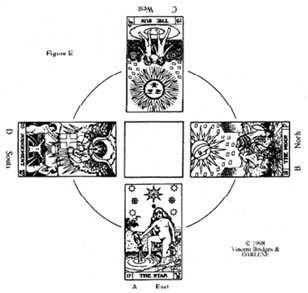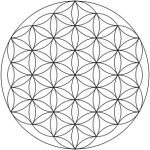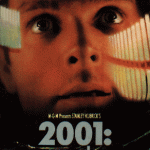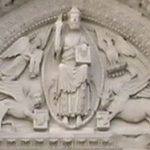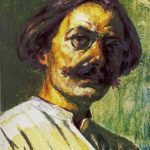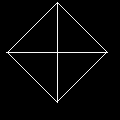What the Monument Tells Us
Armed with all these clues, its time to look directly at the monument and let it speak for itself. If it is a marker of some future catastrophe, then exactly how does it tell us this? And, even more important, does it tell us when?
At first glance, the monument divides itself into three basic components; the upper cross, the column or pillar and the pedestal base. The upper cross has three symbolic components, the pillar is its own symbol and the base has four symbols for a total of eight symbolic images. We can think of the entire monument as a schematic, exploded view perspective of a single geometrical egg, the philosopher’s stone.
The upper cross’ three symbolic components are the INRI inscription, the double X’s and the oddly broken Latin inscription. These symbols offer us three inter-related meaning systems, which, when taken together, give us the key to understanding the entire process symbolized by the monument.
The pillar offers us a unifying image that cuts across all scales of interpretation.
The base’s four symbols must be taken as a unit, one in which the order and meaning of the symbolic components are in a constant state of flux, but the nature of the whole is constant. The images are, starting in the east and going counter-clockwise: 1) an eight-rayed star-burst, 2) an oddly shaped half moon/boat with an eye spot marking, 3) an angry sun face with bulging spiral eyes, dumb-bell shaped mouth and prominent chin; the face is surrounded by 16 large spikes and 16 smaller spikes inside a containing outer circle. The sun circle itself is surrounded by four stars, placed in the corners of the rectangle and tilted so that their diagonal axis continues through the center point of the sun face, and 4) an oval that fills the entire space of the rectangle and contains a cross with four A’s in it. The A’s are unusual, having a sharply angled cross bar nestled in the top angle of each A, rather than the usual horizontal cross bar.
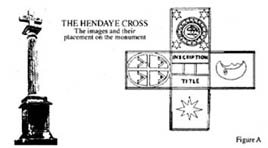
As a whole, the monument gives us a symbol set order that can be expressed as (3 + (1) + 4). Here, we need only note the essential octave structure of the monument’s symbolism with its suggestion of a spiraling mechanism.
Interpreting the Message
Now, let’s look at each symbolic component in depth. Once we have an understanding of each image, then we will try to put them together into the overall meaning.
A) The Upper Cross
1) The INRI inscription – With this image we are placed firmly within the Rosicrucian Alchemical tradition. As Fulcanelli tells us, this inscription can be interpreted as one of the key maxims of alchemy: Igne Natura Renovatur Integra or “By fire nature is renewed whole.” It is also Igne Nitrum Raris Invenitum or “The shining is rarely found in fire.” Perhaps a more accurate way to view these four letters is as the initial letters of the Hebrew names of the elements: Yam, water, Yod or I; Nour, fire, Nun or N; Ruach, air, Resh or R; and Yebeshas, earth, and Yod or I again. (See Figure B.)
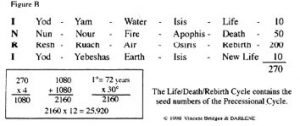
In the Golden Dawn, these letters were considered the “Key Word” and subjected to a peculiar sort of gnostic and kabbalistic analysis. First the four letters are converted into their Hebrew equivalents as for the elements. These letters are then given their Yetsiratic, that is zodiacal and planetary, correspondences: Yod = Virgo; Nun = Scorpio; Resh = The Sun; and back to Yod = Virgo.
From this a pattern can be abstracted: Life, Death, Resurrection and New Life. The Golden Dawn then applied Egyptian god forms to these concepts: Life = Isis; Death = Apophis; Resurrection = Osiris. From this they derived the name of the Gnostic High God IAO. These vowels had long been associated with a mysticism of light, as shown by their prominence in the Bahir, a work of Hebrew mercabah mysticism.
We should also keep in mind that another version of INRI can be read as Isis Naturae Regina Ineffabilis or “Isis, the undefinable Queen of Nature.” In Hebrew, the value of the letters, Yod =10, Nun = 50, Resh = 200, and another Yod, equals 270, which is the value of the Hebrew word “bar” or lever.” The number 270 is of course one of the precessional numbers, as 8, the value of all the symbols in the monument, times 270 = 2160, or the number of solar cycles in one precessional month (12 x 2160 = 25,920 years, or one complete precessional cycle or year).
Therefore, our first symbol tells us of a basic elemental pattern, that of life/death/resurrection, which is related to the mysteries of light, the fire where the shining can be found, and the precessional cycle caused by the earth’s tilted axis.
2) The Double X’s – On the top piece of the cross, on the opposite side from the INRI inscription and above the Latin inscription are two X’s stacked one on top of the other. The first impression is that of the Roman numeral twenty written vertically. Fulcanelli goes to great lengths to call our attention to it without giving the most obvious meaning, that of Trump or Atu or Key XX of the Tarot, the Last Judgment. He does tell us that he already knew the meaning from looking at the images on the pedestal, where the Last Judgment is indeed portrayed.
Fulcanelli is not misleading us however. The snake of the ecliptic is very important, even if it is nowhere else attributed to the Greek Khi. The pattern formed by the two X’s on top of each other is indeed a diagram of the ecliptic, with the cross mark of the Xs showing the equinoxes. It is also a pattern for the transmutation of the elements, viewing their symbols, bared and unbarred triangles, as the Xs themselves.
This symbol tells us that the Last Judgment is the time when the elements, described by the INRI inscription, align in the right way, X marks the spot, on the equinoxes. (See Figure C.)
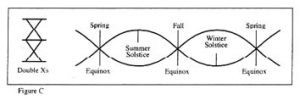
3) The Latin Inscription – Given the love of cryptograms by everyone who has ever been involved with this mystery, we should be very cautious here. Fulcanelli himself warns that “in reality, we should carry carelessness and ignorance to the pitch of disregarding the elementary rules of grammar.” He also recommends “plain common sense, logic and reasoning.”
When we apply that to the Latin inscription, we do not get a complex anagram kind of code. It must be something simple and virtually in plain sight.
The obvious meaning, “Hail O Cross, the Only Hope,” should not be discarded, but, applied to the Xs above, can point to a heavenly cross as much as to anything Christian. But the odd split does suggest a hidden meaning. Given Fulcanelli’s insistence on an S or snake interpretation, it is curious that spes backward is seps, or snake. Reading this word backward produces “Hail, O Cross, The Only Snake,” another reference to the ecliptic perhaps. Pes, or foot, is clearly shown, although unica does not agree with it. However, if we transpose two letters in unica, we have uncia, or “the 12th part.” This agrees with pes and can be translated “the measure of the 12th part.” If we look at the top line, we are left with two letters that are not really needed, the o and the s. Putting these together at the beginning of the sentence gives us Os crux ave pes uncia, or “The essence of the cross salutes the measure of the 12th part.” We can also read it as Os crux ave spes/seps unica, or “The essence of the cross salutes the Only Hope/Snake.”
From all of these, we get an immediate complex of meanings. Just from a glance at the inscription, we can tell that the secret concerns a cross and a snake which somehow measures the 12th part. The inscription is telling us that the monument is a way to measure when the snake and the crosses coincide. It also suggests that this knowledge is our only hope.
B) The Pillar
This is the single symbol in itself that unifies the whole vision. It is the world axis, the spine of the world, the world tree and the tree of life simultaneously. The Egyptians thought of it as the Djed, the backbone of Osiris, the polar axis of the planet and the galactic meridian. It is the stable axis through the center of the galaxy that anchors the moving axis of the precession of the equinoxes. The Egyptians celebrated a re-alignment of the Djed pillar every 27, 54 and 108 years. These are of course our precessional numbers, reduced by a factor of ten.
Here, it suggests that a Djed-like function, that of precessional re-alignment, is the connecting concept between the symbolic meaning of the upper cross and how this meaning is played out in the multi-leveled cross of the base.
C) The Base or Pedestal
Given Fulcanelli’s identification of the double Xs by means of one of the images on the base, we can only surmise that one of these four images was indeed meant to represent the Tarot trump The Last Judgment. From the amount of space Fulcanelli devotes to its explication, the image of the oval and the four As is the most likely candidate for the Last Judgment image.
Which leaves the star, the moon and the sun, images that Fulcanelli does not comment on at all. He does however go on at great length about the four-fold attributes of the Last Judgment, insisting that we pay attention to the four evangels and their kerubic forms. Fortunately, all of this relates to the pedestal as a whole as much or more than it relates to the four As of the Last Judgment.
To understand this, we must spend some time ordering space in Rosicrucian terms. We begin with the directions, east, south, west, north. Each of these directions has an inner, or micro-cosmic, arrangement of elemental qualities and an outer or macro-cosmic arrangement. Therefore, East = both air & fire; South = both fire & earth; West = both water & air; and North = both earth & water. Note the crossing over mixture of active and passive elements, from active/active to passive/passive. This directional and elemental matrix gives us a form around which to spiral the different meanings of the images on the base. (See Figure D.)
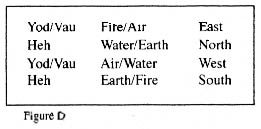
Once we have our directions and their elemental quality, then we must align the images. with them Fulcanelli tells us that the front of the monument is the side with the INRI inscription. This is also the face with the Star image, and should be placed facing the east. If we do that, then the sun is facing west, the moon is facing north and the Last Judgment, the four As, is facing south. Since we have identified one of these images as a Tarot card, it is easy to see the other three as their equivalent cards, number XVII, The Star, number XVIII, The Moon and number XIX, The Sun. (See Figure E.)
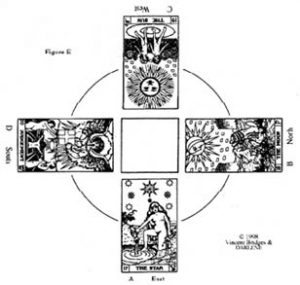
Reading the images in their tarot card order produces a counterclockwise, or packing, flow, in both the macro-cosmic and micro-cosmic order. Starting in the east and reading clockwise unfolds both cosmic patterns in their unpacking, unfolding into being, order. These two patterns symbolize the “divine cross above” and “global cross” below that Fulcanelli mentions. From this we can also see the intersection of the counterclockwise precessional motion and the clockwise yearly motion of the sun. (See Figure F.)
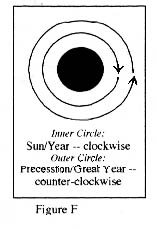
Just from this, without any further identification of the images, we have validated the meaning of the upper cross. The monument does act as a device set to measure the intersection of these two great cycles. The X mark where the snakes cross.
However, our Rosicrucian usage suggests that there is even more ways to develop this pattern. The initiates of the Rose Cross used five more patterns to move elemental energy through the circle. These are the three “flash” patterns and two cross patterns which fill in the interior of the circle with a crossed square design. (See Figure G.)
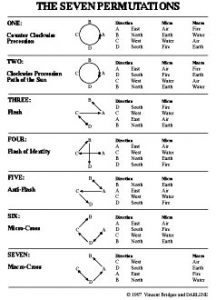
The flashes can be thought of as the lightning flash of creation, the flash of identity, and the anti-flash of destruction. The flashes are internal or micro-cosmic processes, so the elemental attributions don’t shift, just the direction of the flow. To help see the pattern, let’s label the images: A = Star, B = Moon, C = Sun and D = Judgment.
The lightning flash of creation then becomes: D, fire; C, water; A, air; B, earth. The flash of identity is A, air, C, water; B, earth; and D, fire. This flash folds back in on itself across the center, hence its sense of identity. The anti-flash is actually the reverse of the flash, going B, A, C, D. The meaning behind the flash patterns lies in the arrangement of the four letters in YHVH. The lightning flash is the creational pattern of nature, spelling out YHVH. The flash of identity involves the center point, which is thought of as Shin, the letter Sh, which transforms the natural YHVH into YHShVH, or Joshua, Yeheshua or Jesus. In this view, Jesus is the very self-reflexive light of sentience itself.
The crosses come in two kinds, micro and macro. The micro-cosmic cross, that is forming the cross of the elements in the micro-cosmic order, (A, B, D ,C) creates a mirror image of the flash, a sort of reflected flash. This represents the reflexive nature of internal creation. The macro-cosmic cross, that is forming the cross of the elements from the macro-cosmic order, (C, D, A, B) creates a counterclockwise flow similar to the precessional pattern, except that this one is half the zodiac off, starting in the west, not the east.
These patterns define a way of balancing elemental qualities within the interlocking flow of precessional forces and solar forces. These forces manifest the same way on both the internal, micro, and the external, macro, levels of being. The internal forces of the flash define the process of centropic sentience in nature, and is a reflection of the life/death/resurrection pattern of the upper cross. The patterns formed by the cross of the elements serve to unite the internal and the external process.
Taken as a whole, the base seems to be a symbolic measuring device that demonstrates how to unite events on an internal spiritual plane with events taking place on a planetary and galactic scale. This becomes clearer as we move to the meaning of the symbolic images themselves.
The Star, in the Tarot, has the kabbalistic value of 90 and is attributed to the zodiacal sign Aquarius. The Moon has the value of 100 and is the sign Pisces. The Sun has a value of 200 and is the Sun. The Last Judgment has the value of 300 and is the element of fire. Very simply then we read Aquarius/Pisces Sun and (spiritual) fire. Adding their values together gives us 690, an interesting number. In Hebrew it has the same value as the words “candlestick” and “palm tree,” a reference to the menorah and the Djed pillar. However 690 is also the number of years it takes for a lunar eclipse to return to any point in the year, say from winter solstice back to winter solstice. (See Figure H.)
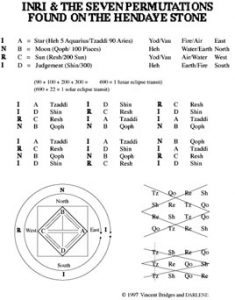
And here we come to a dead end. The patterns can be interpreted for more insight, but basically we are stumped by the puzzle at this point. We have a monument that defines the cross above and the cross below, which is related to the precession of the equinoxes and the Last Judgment. But without a further clue, we can’t make our cosmic clock give us the correct time.
The clue lies within Fulcanelli’s insistence that we pay attention to the four kerubic beasts. These are the lion, the eagle, the man and the bull, which can be equated with the four fixed signs of the Zodiac, Leo, Scorpio, Aquarius and Taurus. Even this clue is not quite enough to help us. It does nothing to orient our calculating monument in space/time.
But, here comes Paul Mevryl to the rescue. Twice, out of context, Mevryl mentions Horus the Elder and Horus-in-the-horizon. This is of course the Sphinx and the Sphinx in the sky, the constellation of Leo. This helps, since Virgo/Leo is the opposite of Aquarius/Pisces. But we still don’t have a starting time for our calculations.
The Golden Dawn however has retained a bit of ancient knowledge that allows us to align our calculating monument. The knowledge lecture on astrology contains the interesting tidbit that if you want to have the constellations in the sky and the earthly houses to line up properly, you must start with Leo on the spring Equinox. (See Figure I.) If we do this, the monument comes to life and produces a date where the snakes cross in the sky. Our point of hope or destruction.
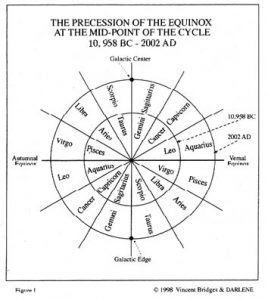
A quick review:
The upper cross is telling us three simple statements. 1) There is an elemental pattern, life/death/resurrection, which is related to the precessional cycle and the renewal of the world by fire. 2) The Last Judgment is the moment when the Xs, the equinoxes, align properly. 3) The monument is designed to measure when the snakes and the crosses coincide, the measure of the 12th part, or the end of a thirteen thousand year cycle.
The pillar, the Djed, grounds us in the local space/time of our galaxy and solar system. It points to a mechanism that re-aligns the planet as the equinoxes precess through the ecliptic.
The base shows us the four-fold pattern of the fixed signs of the zodiac and how to align both zodiacal and elemental qualities in the local cube of space. We can think of this as the global cross in contrast to the divine cross symbolized by the upper cross of the monument. It also defines a local time keeping mechanism, that of the grand lunar eclipse cycle of 690 years, the time it takes a lunar eclipse to proceed from one solstice to the next. (12 months x 11.5 years, the time it takes a full moon to go from solstice to solstice, x 5, the number of full moons between one solstice and the next, = 690 years for a grand lunar eclipse cycle. It is also 30 times the 23 years in a full moon cycle = 690 years.)
Now using Leo on the spring equinox as our starting point, our first X, we arrive at a date of 10,958 BC. Imagine that we are standing between the paws of the newly built Sphinx, looking east just before dawn. It is the night of the full moon, 69 years after the last lunar eclipse on the spring equinox. The moon is low behind the Giza plateau when, about an hour before dawn, Regulus, the heart of the Lion rises in the east. Soon Regulus is joined by the fiery glow of Mars, rising just before the sun. As the sun rises, it enters the constellation Leo and crosses the Vernal Equinox.
If this is the first X, the starting point, then the other X, which must match or align with it, must be the end point. We might think that would the point where the spring equinox returned to Leo, but this produces a date so far in the future, the 15th millennium after Common Era, as to be useless. Maybe it does point to that time as well, but it isn’t relevant to us. The Xs suggest that a similarity between both equinoxes, spring and autumn, is the key. The macro-cosmic cross pattern formed from the images on the base suggests that the key moment occurs when the same images appear at the opposite point in time.
Which means that if Regulus in Leo rose before the sun on the spring equinox, the monument is telling us to look for the opposite point in time, when Regulus again rises before the sun as it enters Leo and crosses the Autumnal Equinox. This gives us our moment in time, supported by the image of the sun on the monument, surrounded by four stars tilted to make the center of the sun face the center of an X. This is an obvious symbol of the equinox, and at this equinox, September 22, 2002, the sun is framed by two stars on one side, Mars and Jupiter, and two stars on the other side, Venus and Mercury. (See Figure J.)
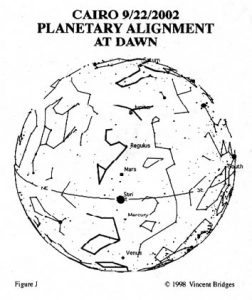
However, this gives us only one arm or axis of the Divine Cross promised by the upper cross of the monument. The Djed pillar gives the other arm of the cross. The Djed is the galactic axis or pillar that our local space/time must be re-aligned with as the planet precesses through the ecliptic. The axis runs from edge to edge of the galaxy through its center. From the earth, the center of the galaxy lies at 0 degree of sidereal Sagittarius, the edge point at 0 degree Gemini. This is an unmoving axis that crosses, as it travels through the plane of the solar system and the orbit of the earth, the moving axis of the local precession of the equinoxes.
Now a “cross” as illustrated by the monument implies a 90 degree angle for the cross arms. If the galactic center lies at the beginning of sidereal Sagittarius, then the moving arm should reach exactly 90 degrees at the equinox where the sun enters sidereal Leo. This is of course our target date of September 22, 2002. Therefore the monument points to the moment of the alignment of the lower cross of the equinox with the greater cross of the galaxy. (See Figure K)
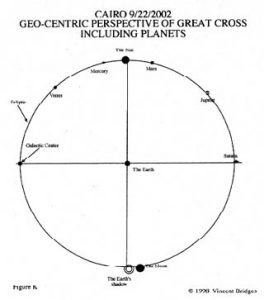
We thank the following organizations for their support of Sangraal.com!
Read reviews of the top USA online casinos at OnlineCasinoUSABonus.com.

